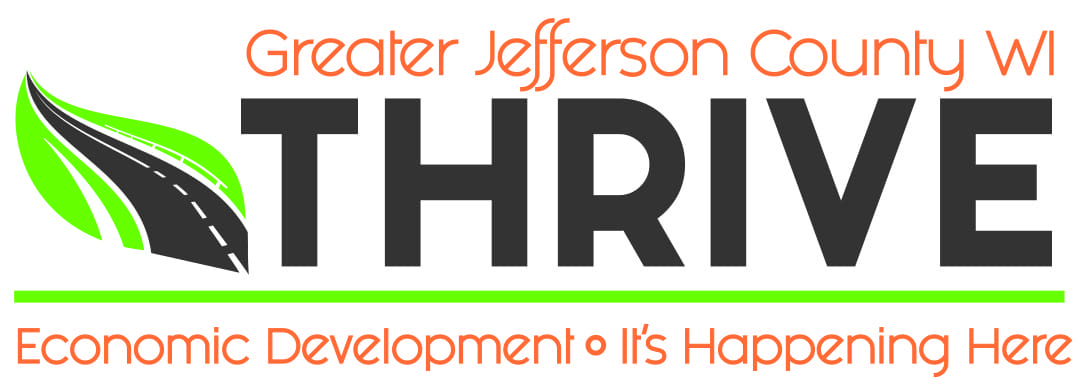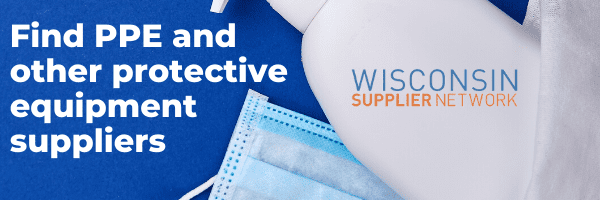The COVID-19 global pandemic has resulted in unprecedented challenges in the United States, and small businesses are being hit particularly hard. Back to Business, a new community business program from Thrive Economic Development (ThriveED) and the Wisconsin Small Business Development Center (SBDC) at UW-Whitewater assists small businesses in Jefferson and Dodge counties as they look for ways to stay afloat during these turbulent times.
Learn more about the Back to Business program, and complete an intake form to get assistance for your business.
In these unprecedented times, Thrive Economic Development will work hard to ensure that businesses in our two-county region have access to the information and resources they need.
Vaccine Guidance for Businesses - UPDATED 4/15/2021
Customizable PowerPoint for Employers
The Wisconsin Department of Health Services has created a customizable PowerPoint presentation for businesses to help communicate with employees about vaccines and other COVID-19 public health best practices.
Download the presentation here
Vaccine Guidance for Employers
Over the last year, Dodge and Jefferson County employers have worked hard to keep employees and customers safe. As COVID-19 vaccinations become available to more people each day, the public health departments for Dodge County, Jefferson County and the City of Watertown are encouraging employers to promote vaccinations to their employees and have created the memo below. The memo contains links to communication resources, vaccine eligibility information, each department’s vaccine information webpage, and forms that need to be completed.
Guidelines and Resources for Businesses - UPDATED 11/15/2020
Workplace Risk Assessment
WisCon is a free, professional consulting service that offers risk assessment services to businesses during COVID-19. Note: WisCon’s COVID-19 services are not connected to a regulatory inspection or reported to the Occupational Safety and Health Administration (OSHA). WisCon can be contacted at 608-226-5246 or by email at covidconsulting@slh.wisc.edu, or you can request assistance on the WisCon website.
COVID-19 Health Alert # 16: Quarantine of Wisconsin residents exposed to COVID-19 is an essential prevention strategy (announced September 9, 2020)
-
- DHS recommends a 14-day quarantine for all Wisconsin residents who were in close contact with a person with COVID-19.
- Close contact is defined as being within 6 feet of an infectious person for 15 minutes or more, unless the uninfected person was using appropriate PPE in a health care setting or similar environment.
- No employment sectors are considered exempt from the quarantine of exposed workers. Quarantine requirements may be modified in circumstances when excluding a person from work could result in an imminent threat to patient care, public health, or public safety. These circumstances should be approved on a case-by-case basis in consultation with local or state public health officials.
- In educational settings, strict adherence to quarantine requirements for students, educators and staff is necessary to minimize the risk of COVID-19 outbreaks.
Blueprint for Reopening Jefferson County
Reopen Guidelines developed by the Wisconsin Economic Development Corporation
The WEDC has developed guidelines with input from national and state health and industry experts for a variety of industries. They will continue to add industries, so we encourage you to check the site often if your industry is not listed.
Metropolitan Milwaukee Association of Commerce (MMAC) Health and Safety Toolkit
MMAC and Medical College of Wisconsin Poster for Businesses
Self-Certification for Best Practices
The guidelines developed by the WEDC represent best practices for a safe reopening for a variety of industries. They are guidelines, not laws. You may want to promote that your business is following the practices set forth in the WEDC guidelines. We have created a self-certification form for businesses to download and customize. Feel free to add your logo and branding, or drop it into another document. You can post the form at your business, or your website or anywhere else your customers will see it. Download the form here.
General Information about COVID-19
Grants & Loans for Businesses - UPDATED 4/29/21
Restaurant Revitalization Registration Opens on April 30
The American Rescue Plan Act established the Restaurant Revitalization Fund (RRF) to provide funding to help restaurants and other eligible businesses keep their doors open. This program will provide restaurants with funding equal to their pandemic-related revenue loss up to $10 million per business and no more than $5 million per physical location. Recipients are not required to repay the funding as long as funds are used for eligible uses no later than March 11, 2023.
Registration for the SBA application portal will begin on Friday, April 30, 2021, at 9 am ET. Applications will open on Monday, May 3, 2021, at noon ET.
Get more details and learn how to apply
Supplemental documents
Paycheck Protection Program Re-Opens Week of January 11, 2021
The Paycheck Protection Program re-opens the week of January 11 for new borrowers and certain existing PPP borrowers. To promote access to capital, initially only community financial institutions will be able to make First Draw PPP Loans on Monday, January 11, and Second Draw PPP Loans on Wednesday, January 13. The PPP will open to all participating lenders shortly thereafter. Updated PPP guidance outlining Program changes to enhance its effectiveness and accessibility was released on January 6 in accordance with the Economic Aid to Hard-Hit Small Businesses, Non-Profits, and Venues Act. Read the full press release here.
Learn more about the PPP at sba.gov
Let us help! The ThriveED Back to Business program can help you with the PPP and other programs and resources. Learn more and fill out an intake form here.
Kiva Loans
Kiva is an international nonprofit with a mission to expand financial access to help underserved communities thrive. Kiva lenders have shown their commitment to providing financial assistance to all by making 0% interest loans to entrepreneurs in the U.S. on Kiva.org for the last 10 years. In today’s difficult circumstances, we’d like to make it as easy and impactful as possible for small businesses in the U.S. to have access to affordable capital on the Kiva platform—capital that may be the difference between shutting down and keeping their doors open.
Unemployment | Wage and Hour Information
Department of Labor Wage and Hour Division
The Wage and Hour Division provides information on common issues employers and employees face when responding to influenza, pandemics, or other public health emergencies, and their effects on wages and hours worked under the Fair Labor Standards Act and job-protected leave under the Family and Medical Leave Act.
Wisconsin Department of Workforce Development Unemployment Insurance
The Wisconsin DWD has compiled a list of frequently asked questions about the COVID-19 Coronavirus and Wisconsin Unemployment Benefits.
Pandemic Unemployment Assistance
PUA is a new temporary federal program that provides up to 39 weeks of unemployment benefits to individuals who are not eligible for regular Unemployment Insurance (UI) such as:
- Individuals who are self-employed.
- Certain independent contractors.
- Individuals with limited recent work history.
- Other workers not covered by Regular UI
Wisconsin plans to start taking PUA applications the week of April 21, 2020. To find out if you are covered by PUA, review these COVID-19 Scenarios.
Workplace Safety/Employer Guidance - UPDATED 11/4/20
Preventing and Managing COVID-19 Outbreaks in the Workplace
This document assists employers when a worker tests positive for COVID-19. It describes how to work with local and tribal health departments (LTHDs) to help keep workers and customers healthy and keep businesses running smoothly during the pandemic.
Working Safely: COVID-19 and Your Job
Frequently Asked Questions about employee rights and safety from the Wisconsin Department of Human Services
Added 4/9/2020 – Interim Guidance for Implementing Safety Practices for Critical Infrastructure Workers Who May Have Had Exposure to a Person with Suspected or Confirmed COVID-19
To ensure continuity of operations of essential functions, CDC advises that critical infrastructure workers may be permitted to continue work following potential exposure to COVID-19, provided they remain asymptomatic and additional precautions are implemented to protect them and the community.
Interim Guidance for Businesses and Employers to Plan and Respond to Coronavirus Disease 2019 (COVID-19)
This interim guidance is based on what is currently known about the coronavirus disease 2019 (COVID-19). COVID-19 is a respiratory illness that can spread from person to person. The outbreak first started in China, but the virus continues to spread internationally and in the United States. The Centers for Disease Control and Prevention (CDC) will update this interim guidance as additional information becomes available.
OSHA Standards for COVID-19
A page on the OSHA website highlighting OSHA standards and directives (instructions for compliance officers) and other related information that may apply to worker exposure to novel coronavirus, COVID-19.
Center for Disease Control and Prevention
This interim guidance is based on what is currently known about the coronavirus disease 2019 (COVID-19). The Centers for Disease Control and Prevention (CDC) will update this interim guidance as needed and as additional information becomes available.
Legislation and Government Directives - UPDATED 9/11/20
COVID-19 Health Alert # 16: Quarantine of Wisconsin residents exposed to COVID-19 is an essential prevention strategy (announced September 9, 2020)
-
- DHS recommends a 14-day quarantine for all Wisconsin residents who were in close contact with a person with COVID-19.
- Close contact is defined as being within 6 feet of an infectious person for 15 minutes or more, unless the uninfected person was using appropriate PPE in a health care setting or similar environment.
- No employment sectors are considered exempt from the quarantine of exposed workers. Quarantine requirements may be modified in circumstances when excluding a person from work could result in an imminent threat to patient care, public health, or public safety. These circumstances should be approved on a case-by-case basis in consultation with local or state public health officials.
- In educational settings, strict adherence to quarantine requirements for students, educators and staff is necessary to minimize the risk of COVID-19 outbreaks.
Emergency Order #1: Relating to preventing the spread of COVID-19 by requiring face coverings
in certain situations (announced July 30, 2020)
Emergency Order requiring individuals to wear face coverings when indoors and not in a private residence, with some exceptions as clarified and defined in the order.
Read the press release here
Read Emergency Order #1 here
Related: Executive Order #82 (issued same day) Declaring a Public Health Emergency
Response to Emergency Order #1 from Jefferson County Sheriff’s Department
Response to Emergency Order #1 from Dodge County Sheriff’s Department
Emergency Order #36: Retail Can Offer Limited In-Person Shopping (announced May 11, 2020)
Emergency Order #36 allows all standalone or strip-mall based retail stores to offer in-person shopping for up to five customers at a time while maintaining required social distancing practices. Additionally, the Emergency Order signed today allows drive-in theaters to operate with some restrictions. All businesses must continue to follow all safety precautions and guidelines as outlined in the Safer at Home order.
Read the press release here
Read Emergency Order #36 here
Safer at Home FAQ document (updated 5/11/20)
Best Practices and Safety Guidelines for Wisconsin Businesses (announced May 8, 2020)
Businesses looking to keep workers, customers and families safe while “turning the dial” toward reopening can now draw on a series of publications to keep them informed of best practices and safety tips. The brochures include general guidelines for all businesses to follow as well as industry-specific advice, such as for restaurants, retailers, manufacturers, professional offices, farmers, manufacturers, builders, hotel and motel operators, barbers, personal care services and other fields.
Read the entire press release here
View the guides on the WEDC website
The CARES Act
The Coronavirus Aid, Relief, and Economic Security (CARES) Act was signed by President Trump on March 27, 2020 to provide direct financial relief to businesses and employees. It includes items like loans for small businesses, changes to SBA loans, payments to individuals, expanded unemployment benefits, work share benefits, and paid leave changes.
WMC CARES Act Summary
Business-Related Tax Provisions in the CARES Act
Small Business Owners Guide to the CARES Act
Safer at Home Goes into Effect March 25 for Wisconsin
View the press release here
View the order here
What is considered an essential business or operation? Learn more here.
Treasury and IRS Issue Guidance on Deferring Tax Payments Due to COVID-19 Outbreak
On March 18, the U.S. Treasury Department and Internal Revenue Service (IRS) issued guidance allowing all individual and other non-corporate tax filers to defer up to $1 million of federal income tax (including self-employment tax) payments due on April 15, 2020, until July 15, 2020, without penalties or interest. Read the press release here.
COVID-19 Legislative Updates from Wisconsin Manufacturers and Commerce
Other Resources - Including Jefferson County Health Department Updates - UPDATED 12/7/20
Jefferson County Health Department Options for Quarantine – issued Dec 7, 2020
This update has been issued following the CDC’s release of options to reduce quarantine for contacts of persons with COVID-19 using symptoms monitoring and diagnostic testing. Quarantine is used to separate someone who might have been exposed to COVID-19 and may develop illness away from other people. The new guidelines for quarantine options shorter than 14 days balance reduced burden against a small but non-zero risk of post-quarantine infection that is informed by new and emerging science.
Read the update here
Jefferson County commUNITY Partner campaign
Jefferson County has launched a “CommUNITY Partner” campaign in effort to provide a unified approach that businesses and residents alike can take to prevent the spread of COVID-19 virus. This campaign will help remind the entire community to remain persistent in their safe practices and still allow their support of the economy and the communities as we continue to reopen.
Jefferson County Health Department COVID-19 dashboard
Printable and shareable graphics promoting mask usage, social distancing and other safety guidelines
America’s Small Business Development Center (SBDC) – Small Business Resources
Wisconsin State Legislature District Maps
Your local elected officials can be a resource during this time. If you have questions and need clarification about the Safer at Home order as it relates to your business, or if you have an opinion to share about business closures and the timeline for businesses re-opening, contact your state representatives. View the district map here to find your local representatives and their contact information.




